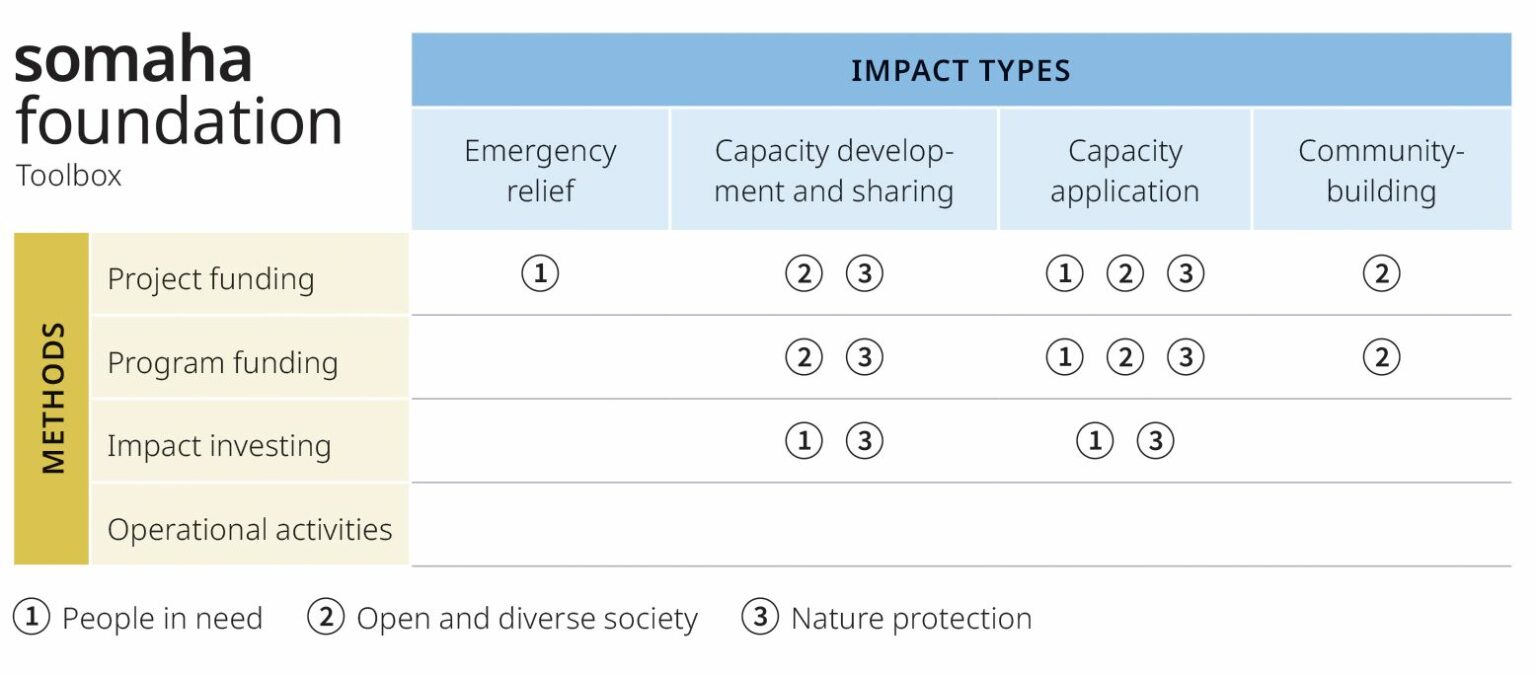Funding
Funding principles
Somaha Foundation follows the following principles in all its activities.
Targeted funding
Diverse funding methods
Strict impact orientation
Partnerships
Needs-oriented support
Shared knowledge
Effectiveness and efficiency
Somaha Foundation selects projects and partner organizations in line with its themes and based on objective and transparent criteria. It supports the selected projects financially and accompanies them throughout the project.
Somaha Foundation uses four funding methods to support its activities: project funding, program funding, impact investing, and operational activities.
Emergency relief, capacity development and sharing, capacity application and implementation, and community-building are the four targeted impact types of Somaha Foundation.
Somaha Foundation partners with other organizations and institutions committed to the same causes to pursue its objectives.
Somaha Foundation shares knowledge and experience from other projects with its partners, enables the use of selected support services such as training or consulting, and encourages the development of networks.
Communication is a central element of the Somaha Foundation’s activities. The foundation strives to communicate its objectives, interests, and activities transparently. It aims to raise awareness about positive initiatives and collaborate with partners to share knowledge and make it accessible to the public.
Somaha Foundation aims to act where its support promises a distinctive and high benefit — but also where this benefit is difficult to measure. The foundation does not see its role in supporting projects for which there are sufficient other funding opportunities.
Forms of funding
Somaha Foundation provides two forms of funding to serve its purpose: multi-year partnerships in all three themes and support for individual projects in the field of nature protection. It launches multi-year partnerships on its own initiative. When supporting individual projects, priority is given to young organizations with new, innovative ideas. Funding requests for nature protection can only be submitted online.
Institutional partnerships
In multi-year partnerships, the foundation collaborates with and supports private non-profit institutions. Partnership agreements with institutions are developed and signed whenever possible.
Funding of individual projects
Private institutions and individuals may apply for funding from the foundation to support their individual projects. The Board of Trustees is responsible for making the final decision on submitted applications. Rejection decisions do not have to be justified.
Funding methods and impact
Somaha Foundation supports initiatives through four funding methods: project funding, program funding, impact investing, and own operational activities. The targeted impact types are emergency relief, capacity development and sharing, capacity application, and community-building. The Somaha toolbox serves as a guideline for the foundation’s funding options. The figure shows how Somaha Foundation’s funding is structured in its three themes.

Funding criteria
Somaha Foundation applies the following criteria to select organizations and projects for funding.
Assessment criteria
Somaha Foundation applies factual, uniform criteria to assess received funding requests and partnership projects. The Board of Trustees and the Somaha office team use the Somaha funding compass to assess project effectiveness and structure, as well as project partners. This enables a transparent evaluation of potential projects and facilitates comparisons between them.
Financial loss, assessable risk of (non-) success of the project, data transparency in the funding request and project
Realistic expectations regarding goals, schedule, staffing, resource use
Quality of content and structure as well as completeness and conclusiveness of the funding request
Long-term, scalable approach; empowerment of the target group or local partner to become independent
Methodological, technical, and social skills, experience, team size, seniority
Clear, reliable, holistic, and timely communication
Openness to process change, error culture, continuous learning, ques-tioning of the status quo, forward-looking organization
Age of the organization, failures, successes, reputation, recognition
Solution approach and impact include forward-thinking elements, not copying existing programs, originality
Consistency with one of the three themes of the foundation and its funding strategy
The project is suitable to achieve its objectives
Subsumption in the United Nations Sustainable Development Goals (SDGs), not (mainly) funded by the public sector, contextual need of the target group, organization, community, closing an existing gap
Financial, material, and human resources are used prudently and in a goal-oriented manner; favorable cost/benefit ratio
Exclusion criteria
Not eligible for funding:
Projects that are part of the core tasks of the public sector.
Projects in a commercial context
Conferences, congresses, symposia
Production of printed material
Coverage of deficits in projects already implemented
Individuals
Institutional partnerships: The foundation does not accept funding requests for multi-year partnerships.
Individual projects: Currently, the foundation accepts funding requests for individual projects exclusively in the theme of nature protection.
Funding concept
Localization is an important concept for Somaha Foundation’s activity, meaning strengthening local organizations and communities by increasing their independence and self-determination. Learn more about our understanding of localization.

FAQ
This page answers the most frequently asked questions about the Somaha funding of projects in the theme of nature protection.
Somaha Foundation engages in the thematic areas of people in need, open and diverse society, and nature protection.
To pursue its objective, Somaha Foundation provides two forms of funding:
Multi-year, institutional partnerships that the foundation enters on its initiative with young and established organizations.
In the theme of nature protection, funding requests can be submitted for individual projects. Here, the focus is primarily on young organizations with new, innovative ideas.
The Board of Trustees makes the funding decision based on the review and recommendation of the Somaha office team.
After signing the partnership agreement, the partnership starts with the first funding tranche transferred to the account of the funding partner.

